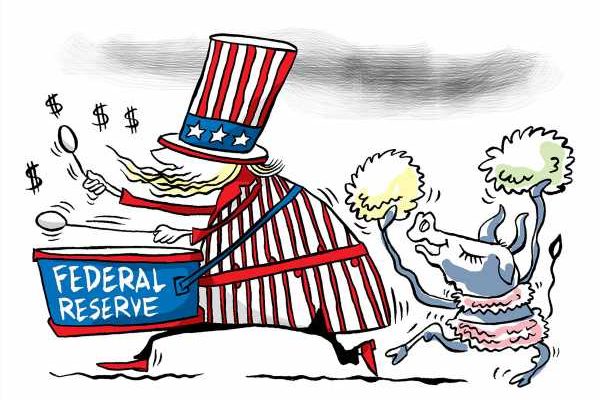The market’s sensitivity to the US Fed’s balance sheet changes makes it vulnerable to the possible tapering of the bond buying programme and the resulting stagnation or even shrinkage in the balance sheet.
Krishna Kant reports.
The rally in the stock markets appears to be tied to the size of the US Federal Reserve’s balance sheet, rather than anything else, according to data.
Major equity indices across the world, including the BSE Sensex and Nifty50, have nearly doubled from the lows hit in March 2020, closely tracking the expansion in the US Fed’s balance sheet and the liquidity in the global financial markets.
For instance, the S&P 500 index — the world’s most traded equity index — has risen 16 per cent since the beginning of calendar year 2021, closely mirroring the 12 per cent rise in US Fed’s balance sheet.
The correlation between Indian market and US Fed balance sheet is stronger still.
The Nifty50 is up 14 per cent year-to-date (YTD) while BSE Sensex is up 11 per cent.
Since the outbreak of the pandemic, the US Fed’s balance sheet has risen 76 per cent from $4.2 trillion in March 2020 to $8.2 trillion.
In the same period, the S&P 500 has grown 90 per cent while Dow Jones Industrial Average has rallied 83 per cent.
In India, the Sensex has doubled from March 2020 lows, while the Nifty has risen 110 per cent. (please see charts)
“Liquidity is a more dominant factor in equity markets than corporate earnings. There was an unprecedented rise in global money supply without a matching rise in economic activity. This created a big pool of excess liquidity, which went into asset markets, including equity,” says Dhananjay Sinha, managing director and chief strategist at JM Financial Institutional Securities.
This is not a particularly new trend. The steady expansion in the US Fed’s balance sheet has been driving stock prices for most of the post Lehman period.
However, markets’ sensitivity to changes in the US Fed’s balance sheet is higher than before.
For example, the US Fed had briefly shrunk its balance sheet in June and July last year after huge monetary expansion from March through May 2020.
This resulted in a stock correction and market volatility.
The global rally in equity prices resumed in September 2020, once the US Fed resumed the expansion of its balance sheet.
Analysts say the equity markets and the US Fed balance sheet are connected through the latter’s bond buying programme, which helps keep interest rates low and provides liquidity to the equities market.
At present, the US Fed is expanding its balance sheet at the rate of around $120 billion a month by buying various kinds of bonds, including mortgage backed securities.
The market’s sensitivity to the US Fed’s balance sheet changes, however, makes it vulnerable to the possible tapering of the bond buying programme and the resulting stagnation or even shrinkage in the balance sheet.
“The US Fed’s easy monetary policy has now heated-up the US housing market and home prices are increasingly out of reach of many buyers,” says Sinha
This coupled with rising inflation is putting pressure on the US Fed to slow and eventually end its bond buying programme,” Sinha adds.
Tapering is expected to lead to a global correction in equity markets, and emerging markets like India are expected to hit hard.
In the past, there was significant correction in stock prices in 2015 and 2018, when the US Fed similarly tried to end its bond buying programme and shrink its balance sheet.
Many analysts expect an even bigger sell-off now.
Source: Read Full Article


